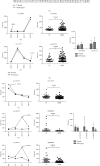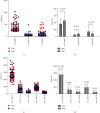Urinary Peptides Associated Closely with Gestational Diabetes Mellitus
- PMID: 32904578
- PMCID: PMC7456494
- DOI: 10.1155/2020/8880034
Urinary Peptides Associated Closely with Gestational Diabetes Mellitus
Abstract
Gestational diabetes mellitus (GDM) is a common disease of pregnant women, which has a higher incidence in recent years. The purpose of this study is to explore urinary biomarkers that could predict and monitor gestational diabetes mellitus (GDM). Urine samples from 30 normal pregnant women and 78 GDM patients were collected and purified by weak cationic exchange magnetic beads (MB-WCX), then analyzed by matrix-assisted laser desorption ionization time of flight mass spectrometry (MALDI-TOF-MS). The urinary peptide signatures of the two groups were compared by BioExplorer software. The potential ability of the differently expressed peptides to distinguish GDM patients from normal pregnant women was evaluated by receiver operating characteristic (ROC) analysis. At last, the differently expressed peptides were identified by liquid chromatography tandem mass spectrometry (LC-MS). There were four differently expressed peptides (m/z 1000.5, 1117.5, 1142.9, and 2022.9) between two groups, which were identified as fragments of urinary albumin, α2-macroglobulin, human hemopexin, and α1-microglobulin, respectively. The diagnostic efficacy of m/z 1142.9 was better than the other peptides. The area under the curve (AUC) of the m/z 1142.9 was 0.690 (95% CI: 0.583-0.796). The discovery of urinary polypeptides provides the possibility for the early prediction of GDM and the monitoring of glucose metabolism in GDM patients by a noninvasive method.
Copyright © 2020 Zhiying Hu et al.
Conflict of interest statement
The authors declare that they have no conflict of interest.
Figures





Similar articles
-
Levels of inter-alpha-trypsin inhibitor heavy chain H4 urinary polypeptide in gestational diabetes mellitus.Syst Biol Reprod Med. 2021 Dec;67(6):428-437. doi: 10.1080/19396368.2021.1977869. Epub 2021 Oct 4. Syst Biol Reprod Med. 2021. PMID: 34607479
-
Screening and analysis of small molecular peptides in urine of gestational diabetes mellitus.Clin Chim Acta. 2020 Mar;502:174-182. doi: 10.1016/j.cca.2019.12.024. Epub 2019 Dec 31. Clin Chim Acta. 2020. PMID: 31901480
-
Identification of urinary biomarkers for type 2 diabetes using bead-based proteomic approach.Diabetes Res Clin Pract. 2013 Aug;101(2):187-93. doi: 10.1016/j.diabres.2013.05.004. Epub 2013 Jun 13. Diabetes Res Clin Pract. 2013. PMID: 23769013
-
Two urinary peptides associated closely with type 2 diabetes mellitus.PLoS One. 2015 Apr 22;10(4):e0122950. doi: 10.1371/journal.pone.0122950. eCollection 2015. PLoS One. 2015. PMID: 25902048 Free PMC article.
-
Metabolomics in gestational diabetes.Clin Chim Acta. 2017 Dec;475:116-127. doi: 10.1016/j.cca.2017.10.019. Epub 2017 Oct 21. Clin Chim Acta. 2017. PMID: 29066210 Review.
Cited by
-
Development and validation of a decision tree classification model for the essential hypertension based on serum protein biomarkers.Ann Transl Med. 2022 Sep;10(18):970. doi: 10.21037/atm-22-3901. Ann Transl Med. 2022. PMID: 36267793 Free PMC article.
-
Proteomic analysis of plasma total exosomes and placenta-derived exosomes in patients with gestational diabetes mellitus in the first and second trimesters.BMC Pregnancy Childbirth. 2024 Oct 30;24(1):713. doi: 10.1186/s12884-024-06919-9. BMC Pregnancy Childbirth. 2024. PMID: 39478498 Free PMC article.
-
Establishment of clinical diagnostic models using glucose, lipid, and urinary polypeptides in gestational diabetes mellitus.J Clin Lab Anal. 2021 Jul;35(7):e23833. doi: 10.1002/jcla.23833. Epub 2021 May 27. J Clin Lab Anal. 2021. PMID: 34042214 Free PMC article.
References
-
- Vogel J. P., Souza J. P., Mori R., et al. Maternal complications and perinatal mortality: findings of the World Health Organization multicountry survey on maternal and newborn health. BJOG: An International Journal of Obstetrics & Gynaecology. 2014;121:76–88. doi: 10.1111/1471⁃0528.12633. - DOI - PubMed
-
- Hod M., Kapur A., Sacks D. A., et al. The International Federation of Gynecology and Obstetrics (FIGO) Initiative on gestational diabetes mellitus: a pragmatic guide for diagnosis, management, and care. International Journal of Gynecology & Obstetrics. 2015;131:S173–S211. doi: 10.1016/S0020-7292(15)30033-3. - DOI - PubMed
MeSH terms
Substances
LinkOut - more resources
Full Text Sources
Other Literature Sources
Medical
Miscellaneous

